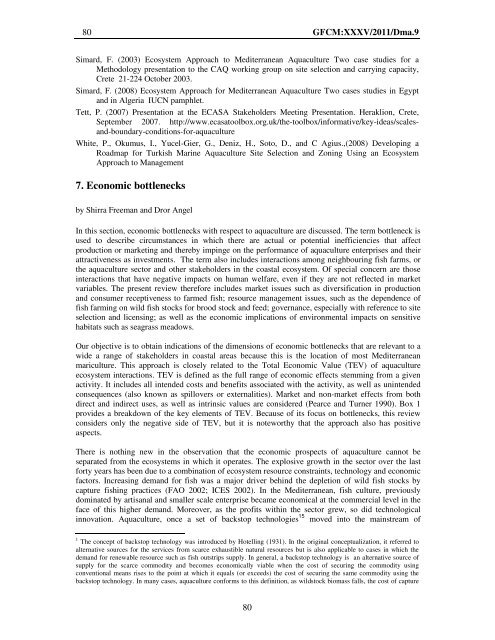Site selection and carrying capacity in Mediterranean ... - FAO Sipam
Site selection and carrying capacity in Mediterranean ... - FAO Sipam
Site selection and carrying capacity in Mediterranean ... - FAO Sipam
Create successful ePaper yourself
Turn your PDF publications into a flip-book with our unique Google optimized e-Paper software.
80 GFCM:XXXV/2011/Dma.9<br />
Simard, F. (2003) Ecosystem Approach to <strong>Mediterranean</strong> Aquaculture Two case studies for a<br />
Methodology presentation to the CAQ work<strong>in</strong>g group on site <strong>selection</strong> <strong>and</strong> <strong>carry<strong>in</strong>g</strong> <strong>capacity</strong>,<br />
Crete 21-224 October 2003.<br />
Simard, F. (2008) Ecosystem Approach for <strong>Mediterranean</strong> Aquaculture Two cases studies <strong>in</strong> Egypt<br />
<strong>and</strong> <strong>in</strong> Algeria IUCN pamphlet.<br />
Tett, P. (2007) Presentation at the ECASA Stakeholders Meet<strong>in</strong>g Presentation. Heraklion, Crete,<br />
September 2007. http://www.ecasatoolbox.org.uk/the-toolbox/<strong>in</strong>formative/key-ideas/scales<strong>and</strong>-boundary-conditions-for-aquaculture<br />
White, P., Okumus, I., Yucel-Gier, G., Deniz, H., Soto, D., <strong>and</strong> C Agius.,(2008) Develop<strong>in</strong>g a<br />
Roadmap for Turkish Mar<strong>in</strong>e Aquaculture <strong>Site</strong> Selection <strong>and</strong> Zon<strong>in</strong>g Us<strong>in</strong>g an Ecosystem<br />
Approach to Management<br />
7. Economic bottlenecks<br />
by Shirra Freeman <strong>and</strong> Dror Angel<br />
In this section, economic bottlenecks with respect to aquaculture are discussed. The term bottleneck is<br />
used to describe circumstances <strong>in</strong> which there are actual or potential <strong>in</strong>efficiencies that affect<br />
production or market<strong>in</strong>g <strong>and</strong> thereby imp<strong>in</strong>ge on the performance of aquaculture enterprises <strong>and</strong> their<br />
attractiveness as <strong>in</strong>vestments. The term also <strong>in</strong>cludes <strong>in</strong>teractions among neighbour<strong>in</strong>g fish farms, or<br />
the aquaculture sector <strong>and</strong> other stakeholders <strong>in</strong> the coastal ecosystem. Of special concern are those<br />
<strong>in</strong>teractions that have negative impacts on human welfare, even if they are not reflected <strong>in</strong> market<br />
variables. The present review therefore <strong>in</strong>cludes market issues such as diversification <strong>in</strong> production<br />
<strong>and</strong> consumer receptiveness to farmed fish; resource management issues, such as the dependence of<br />
fish farm<strong>in</strong>g on wild fish stocks for brood stock <strong>and</strong> feed; governance, especially with reference to site<br />
<strong>selection</strong> <strong>and</strong> licens<strong>in</strong>g; as well as the economic implications of environmental impacts on sensitive<br />
habitats such as seagrass meadows.<br />
Our objective is to obta<strong>in</strong> <strong>in</strong>dications of the dimensions of economic bottlenecks that are relevant to a<br />
wide a range of stakeholders <strong>in</strong> coastal areas because this is the location of most <strong>Mediterranean</strong><br />
mariculture. This approach is closely related to the Total Economic Value (TEV) of aquaculture<br />
ecosystem <strong>in</strong>teractions. TEV is def<strong>in</strong>ed as the full range of economic effects stemm<strong>in</strong>g from a given<br />
activity. It <strong>in</strong>cludes all <strong>in</strong>tended costs <strong>and</strong> benefits associated with the activity, as well as un<strong>in</strong>tended<br />
consequences (also known as spillovers or externalities). Market <strong>and</strong> non-market effects from both<br />
direct <strong>and</strong> <strong>in</strong>direct uses, as well as <strong>in</strong>tr<strong>in</strong>sic values are considered (Pearce <strong>and</strong> Turner 1990). Box 1<br />
provides a breakdown of the key elements of TEV. Because of its focus on bottlenecks, this review<br />
considers only the negative side of TEV, but it is noteworthy that the approach also has positive<br />
aspects.<br />
There is noth<strong>in</strong>g new <strong>in</strong> the observation that the economic prospects of aquaculture cannot be<br />
separated from the ecosystems <strong>in</strong> which it operates. The explosive growth <strong>in</strong> the sector over the last<br />
forty years has been due to a comb<strong>in</strong>ation of ecosystem resource constra<strong>in</strong>ts, technology <strong>and</strong> economic<br />
factors. Increas<strong>in</strong>g dem<strong>and</strong> for fish was a major driver beh<strong>in</strong>d the depletion of wild fish stocks by<br />
capture fish<strong>in</strong>g practices (<strong>FAO</strong> 2002; ICES 2002). In the <strong>Mediterranean</strong>, fish culture, previously<br />
dom<strong>in</strong>ated by artisanal <strong>and</strong> smaller scale enterprise became economical at the commercial level <strong>in</strong> the<br />
face of this higher dem<strong>and</strong>. Moreover, as the profits with<strong>in</strong> the sector grew, so did technological<br />
<strong>in</strong>novation. Aquaculture, once a set of backstop technologies 15 moved <strong>in</strong>to the ma<strong>in</strong>stream of<br />
1 The concept of backstop technology was <strong>in</strong>troduced by Hotell<strong>in</strong>g (1931). In the orig<strong>in</strong>al conceptualization, it referred to<br />
alternative sources for the services from scarce exhaustible natural resources but is also applicable to cases <strong>in</strong> which the<br />
dem<strong>and</strong> for renewable resource such as fish outstrips supply. In general, a backstop technology is an alternative source of<br />
supply for the scarce commodity <strong>and</strong> becomes economically viable when the cost of secur<strong>in</strong>g the commodity us<strong>in</strong>g<br />
conventional means rises to the po<strong>in</strong>t at which it equals (or exceeds) the cost of secur<strong>in</strong>g the same commodity us<strong>in</strong>g the<br />
backstop technology. In many cases, aquaculture conforms to this def<strong>in</strong>ition, as wildstock biomass falls, the cost of capture<br />
80
















